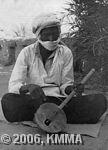

The kiiki is a one-string fiddle that is played with a bow. The shape and the construction of the kiiki are the same as the keleli fiddle. The difference lies in the strings: the lute has two or three strings whereas the fiddle only has one. This string is made of a dozen or so strands of horse-hair, imported from Libya and Niger, since the Teda do not have horses.
The other important component of the kiiki is the bow, which is made from a pliable twig and horse-hairs tied together. Resin is rubbed into the hair just before the musician begins to play. This improves the friction when the hairs of the bow are drawn across the hairs of the string. Playing slackens the tension in the string and gradually makes the instrument go out of tune. If the pitch deviates too much, the musician stops playing and retunes the instrument.
The fiddle is held at an angle with the sound box resting on the ground and pressed against the player's knees or feet. The neck is at an angle and reaches chest-height; the player holds the neck with his left hand at chest-height. The string is stopped with four fingers and mainly the middle phalanx is used. The little finger is not used. The bow is held in the right hand.
The music played on the kiiki is mainly instrumental, but sometimes it is accompanied by a bourdon-like humming in the letter zzz, or a low, quiet whispering of a text.
Learning to play the kiiki is primarily done through listening and imitation, but is developed through self-tuition by the player. The repertoire is not as extensive as that of the keleli. Four different songs were entered in the records: delayla, lele, kaikore and bela. Glissando is a common technique in which the string is bowed while the musician slides his other hand slowly along the string, from high to low and back again. This simple technique is used by many musicians, particularly those who are not very good at playing the fiddle.
Sometimes a lute is converted to a fiddle or vice versa by changing the strings.
See also: BRANDILY, M., Instruments de musique et musiciens instrumentistes chez les Teda du Tibesti, RMCA – Human Sciences, Annals Vol. 82, 1974
© KMMA/Monique BRANDILY